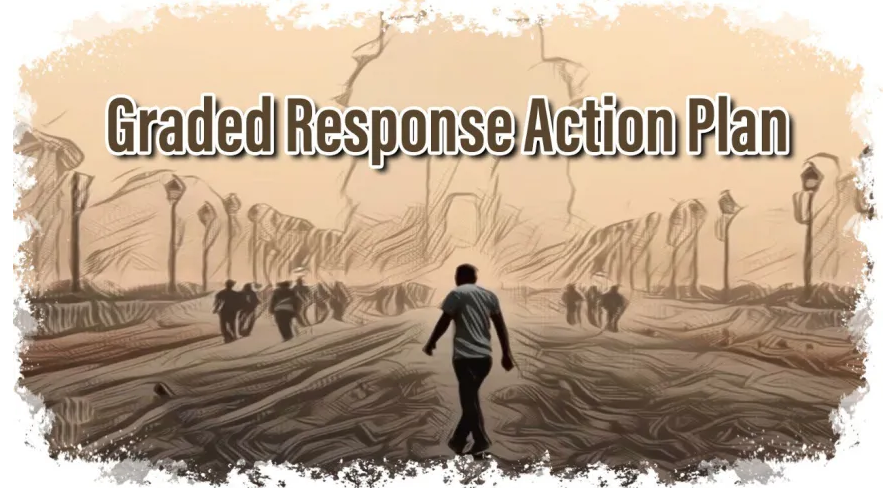Graded Response Action Plan (GRAP) (GS Paper 2, Governance)

Context
- The Commission for Air Quality Management (CAQM) has recently invoked Stage I of the Graded Response Action Plan (GRAP) across the entire National Capital Region (NCR).
- This decision was prompted by Delhi’s daily average Air Quality Index (AQI) reaching 234, categorizing the air quality as "poor."
- This action highlights the urgent need for coordinated efforts to address air pollution, especially as deteriorating air quality poses significant health risks to the population.
Stages of GRAP
The GRAP classifies air quality into four distinct stages based on AQI readings, with each stage triggering specific response measures:
- Stage I: Poor (AQI 201 - 300)
At this stage, initial measures are implemented to mitigate pollution, including promoting public transportation and regulating construction activities.
- Stage II: Very Poor (AQI 301 - 400)
More stringent actions are initiated, such as implementing vehicle restrictions and shutting down certain industrial activities.
- Stage III: Severe (AQI 401 - 450)
This stage triggers emergency responses, including additional bans on construction activities and measures to control dust emissions.
- Stage IV: Severe + (AQI > 450)
The most severe measures are enforced, which may include shutting down schools and colleges, and restricting all non-essential activities.
As of October 15, 2024, all 27 action points under Stage I have been activated throughout the NCR, signaling a proactive approach to tackle air quality issues.
Commission for Air Quality Management (CAQM)
- Establishment: The CAQM was established in 2020 as a permanent authority to manage air quality in the NCR. This replaced the Environmental Pollution (Prevention and Control) Authority (EPCA), which had been in operation for over two decades.
- Objectives: The CAQM's primary goals include:
- Enhanced Coordination: Facilitating collaboration among various government agencies and stakeholders involved in air quality management.
- Research and Development: Conducting studies to understand the sources of air pollution and evaluating the effectiveness of mitigation strategies.
- Problem Resolution: Identifying and addressing challenges related to air quality in the NCR.
- Composition: The CAQM comprises at least six permanent members, including a chairperson who is either a former or current Secretary of the Government of India or a Chief Secretary from a state government. This structure ensures that the commission is well-equipped to make informed decisions.
Overview of GRAP
- Purpose: The GRAP serves as an emergency response mechanism designed to address air quality deterioration in Delhi-NCR. It aims to unify various stakeholders—including government bodies, local authorities, and environmental agencies—to respond swiftly to changing air quality conditions.
- Notification: GRAP was officially notified by the Ministry of Environment, Forests & Climate Change (MoEF&CC) in January 2017, following recommendations from the Central Pollution Control Board (CPCB). This formal acknowledgment underscored the need for a structured response to air quality crises.
- Coordination Among Agencies: The plan mandates cooperation among 13 different agencies across the NCR, including those from Delhi, Uttar Pradesh, Haryana, and Rajasthan. This multi-state collaboration is crucial, given that air pollution often transcends regional boundaries.
National Air Quality Index (NAQI)
- Launch: The NAQI was launched in 2014 as part of the Swachh Bharat Mission, reflecting the government's commitment to improving air quality.
- Functionality: The NAQI is a comprehensive tool for communicating air quality status to the public, allowing citizens to understand the health implications of current air quality conditions.
- Pollutants Monitored: The index evaluates air quality based on eight major pollutants:
- Particulate Matter (PM10 and PM2.5): Fine particles that can penetrate the respiratory system and cause health issues.
- Nitrogen Dioxide (NO2): A pollutant primarily from vehicle emissions, contributing to respiratory problems.
- Sulfur Dioxide (SO2): Emitted from industrial processes and fossil fuel combustion, it can lead to acid rain.
- Carbon Monoxide (CO): A colorless, odorless gas produced from incomplete combustion, which can be harmful in high concentrations.
- Ozone (O3): A secondary pollutant formed by the reaction of sunlight with pollutants like volatile organic compounds (VOCs) and NOx, which can aggravate respiratory conditions.
- Ammonia (NH3): Released from agricultural activities and waste management, it contributes to secondary particulate formation.
- Lead (Pb): A toxic metal that can harm multiple organ systems, primarily from industrial emissions and the use of leaded fuels in the past.
Conclusion
- The invocation of Stage I of the GRAP reflects an urgent and proactive approach to managing air quality issues in the NCR.
- The CAQM, along with the NAQI, provides a robust framework for addressing the complex challenges posed by air pollution.
- Through coordinated efforts and a multi-agency approach, the government aims to mitigate the health impacts of poor air quality while fostering public awareness and engagement.
- By implementing effective action plans and promoting sustainable practices, the GRAP not only seeks to improve air quality but also strives to create a healthier and more resilient environment for the residents of Delhi and the surrounding regions.


